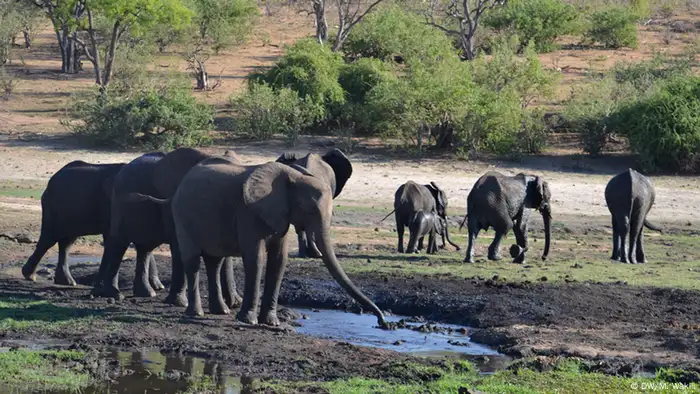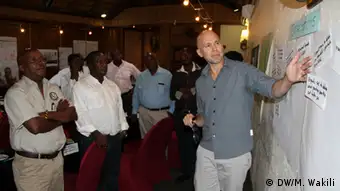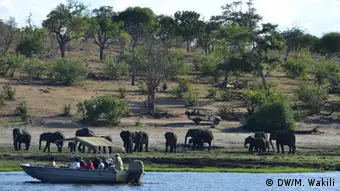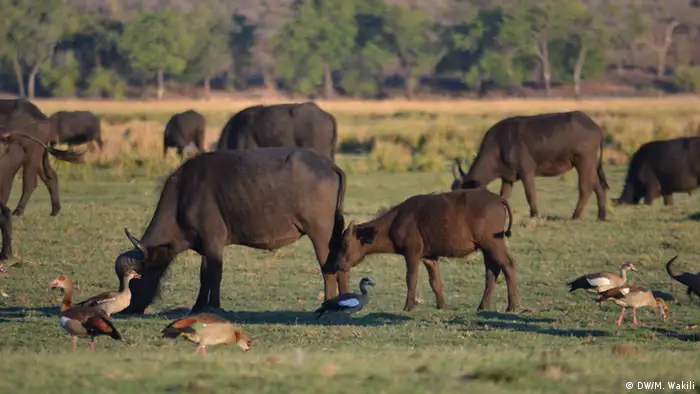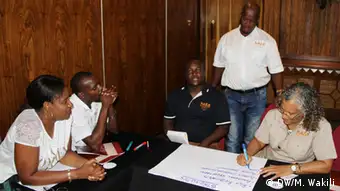Communications consulting
KAZA: Africa's Schengen for animals
In the middle of Chobe National Park in Southern Africa, a DW Akademie team views the KAZA project for themselves. The biggest conservation area on earth needs a communications strategy and DW Akademie is there to help.
It is a small foretaste of what's called "human-wildlife conflict" in animal conservation circles, and it's one of the topics that will come up often in this rather unusual DW Akademie workshop. Its focus is nothing less than the largest transfrontier conservation area in the world and how humans and animals can live together in harmony.
The two rivers, the Okavango and Zambesi, have lent their names to both the area and the project: the Kavango-Zambezi Transfrontier Conservation Area or "KAZA" for short. At first glance, the project looks fairly straightforward, but in reality it is extremely complex - not least because of its huge geographical dimensions. It involves an area of over 500,000 square kilometers spread out over five countries, Angola, Botswana, Namibia, Zambia and Zimbabwe. Roughly the size of Sweden, the area encompasses 36 national parks, game reserves, protected areas and villages, all of which are currently scattered like islands across the five countries.
One of KAZA's key goals is to connect these islands via a series of wildlife corridors. The resulting network would be safer for nature, wildlife and humans alike. And that brings us back to the issue of "human-wildlife conflict," because wherever humans and animals depend on a shared natural environment, their different needs and interests often spell conflict. For example, when elephants help themselves to a midnight snack in a cornfield or simply stroll through when on a moonlight walk, there's often not much left over for humans. How to achieve peaceful and viable coexistence?
Sustainable eco-tourism
Various ideas have been tabled about how to help resolve such conflicts. Creating wildlife corridors, which animals can safely navigate without causing any harm, is just one example. Another idea is to use so-called "chili-bombs," a mixture of elephant dung and chili. Adding a red-hot coal to the mixture creates an acrid-smelling smoke that gets up the elephants' sensitive noses and convinces the pachyderms to choose another route. However, it's essential that all routes permit the animals to freely cross borders, a kind of "Schengen for animals."
In order to finance all this and make it sustainable, the plan is to develop and expand eco-tourism in the area. With just a single visa, tourists will eventually be allowed a month of unrestricted travel in the KAZA areas of all five countries. Zambia and Zimbabwe already offer this visa, and the remaining three KAZA partner countries are set to follow.
"We're very happy to be able to support KAZA in this important endeavor," says Michael Tecklenburg, head of DW Akademie's Africa team. "What's especially exciting is the ambitious goal of making this a win-win, both for the protection of biodiversity and for local development and poverty reduction." The biggest foreign donor, the German Federal Ministry for Economic Cooperation and Development (BMZ), is supporting the project to the tune of 35.5 million Euros via the KfW Development Bank.
Every day the KAZA Secretariat team, from its office in the middle of Chobe National Park, works on overcoming obstacles: for example, tedious bureaucratic coordination processes on different levels and involving different target groups. It's a challenge that the Secretariat finds almost insurmountable without the benefit of a viable communications strategy.
That's why, at the start of 2015, the Secretariat turned to DW Akademie. Morris Mtsambiwa, head of the Secretariat, explains what his team stands to gain from DW Akademie expertise. "We wanted an external perspective and international communications experts who could give us tips on how to tell the world what KAZA is all about: a combination of nature conservation, tourism and sustainable development for the local people."
Communicating key messages
The key issues are so complex that one could study them for weeks or even months. The Okavango Delta and the mighty Victoria Falls may be familiar to most people, but very few are aware that they're also part of KAZA.
A successful communications strategy is the first step towards changing that. Daniela Wiesler, head of media training and communications for DW Akademie, emphasizes the "huge potential" that this project represents. "There are many unique aspects to KAZA that can be wonderfully communicated. One just has to know how." During the weeklong workshop, the KAZA team and representatives from the KAZA countries were able to resolve their most important questions: What is the project's key message? How can we effectively communicate our vision?
But what at first seemed fairly straightforward, turned out to be a major challenge. So the participants worked hard together to find solutions and were all the more satisfied when they managed to create a solid communications strategy by the end of the workshop. Morris Mtsambiwa is proud of the achievement. "I became aware of how crucial communication is to this process. Regardless of how effective we are as conservationists, it's only through targeted public communications that our work can get the attention it deserves."
He is also convinced that this is the only way to one day resolve the broader "human-wildlife conflict." In the meantime however, if you want to avoid bumping into elephants or lions in the nighttime, at least in Kasane, it might be a good idea to continue heeding the excellent advice of our driver.
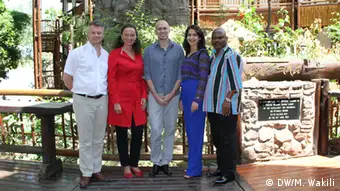
(Left to right) The DW Akademie Team: Christopher Springate, Daniela Wiesler, Kyle James and Merjam Wakili, with William Mabasa, advisor for Kruger National Park
The goal of the Kavango-Zambezi Transfrontier Conservation Area (KAZA) project is to create a transfrontier conservation area (TFCA) that stretches over large parts of five African countries: Angola, Botswana, Namibia, Zambia and Zimbabwe. In 2006, the five republics signed a memorandum of understanding, and in 2011, the countries' presidents signed a treaty that formally and legally established the TFCA. KAZA covers over 500,000 square kilometers between the Okavango and Zambesi rivers. In 1997, the Peace Parks Foundation was created specifically to promote TFCAs or Peace Parks. Today there are 24 Peace Parks on the African continent, of which KAZA is the largest.
DW recommends
- Date 15.01.2016
- Author Merjam Wakili / mc
- Feedback: Send us an e-mail. Please include your name and country in your reply.
- Print Print this page
- Permalink https://p.dw.com/p/1He1h
- Date 15.01.2016
- Author Merjam Wakili / mc
- Send us your feedback.
- Print Print this page
- Permalink https://p.dw.com/p/1He1h

